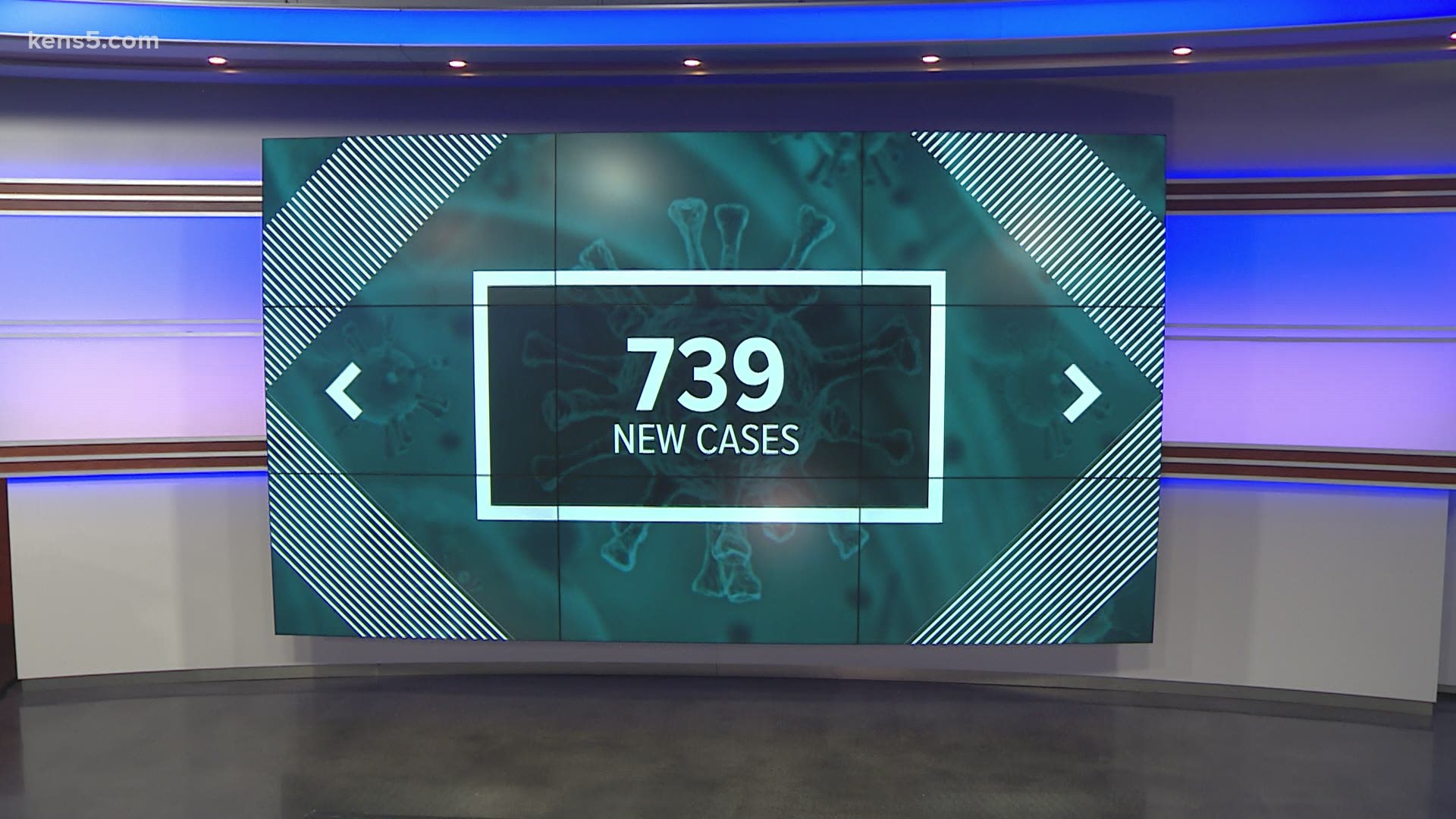SAN ANTONIO — We're tracking the latest numbers from the coronavirus pandemic in San Antonio and across Texas. Here are the latest numbers reported by Bexar and surrounding counties:
- Bexar County: On Sunday, 739 new cases were reported, along with1,451 backlogged cases—bringing the total number of cases to 183,201. Three new deaths were also reported, but the death toll is up to 2,361 as 150 backlogged fatalities were reported.
- Hays County: On Friday, officials reported 163 new cases in the county and three additional COVID-related fatalities. As of Friday, there are a total of 15,378 lab-confirmed local cases, while the death toll rose to 198. Officials estimate 13,235 residents have recovered, while 1,945 are still ill with the virus.
- Comal County: On Friday, officials reported 39 new cases as well as an additional 69 backlogged cases. No additional COVID-related fatalities were reported. There are a total of 8,435 cases, including 4,403 confirmed and 4,016 probable cases, while 259 county residents have died due to COVID-19 complications. The county estimates 7,584 residents have recovered, while 592 are still ill with the virus.
More county case information is available through the Texas Department of Health Services COVID-19 dashboard.
How Bexar County is trending
We've tracked how many coronavirus cases have been confirmed in Bexar County from the time officials began reporting cases in March 2020. The graphic below shows the number of cases since June and charts those daily case numbers along a 7-day moving average to provide a more accurate picture of the overall coronavirus case curve in our area and the direction we're trending amid the pandemic.
On Sunday, Metro Health updated its online coronavirus-tracking dashboards to reflect an additional 2,190 coronavirus cases in Bexar County; of those, 739 are new diagnoses and 1,451 are backlogged cases. At least 183,201 county residents have been diagnosed with COVID-19.
The seven-day moving average of new local cases increased slightly to 1,228.
Metro Health also tallied three new virus-related deaths (which are deaths from the last 14 days) but the death toll for Bexar County jumped to 2,361 as 150 backlogged deaths from coronavirus complications were reported. Health authorities say those deaths occurred between Dec. 10 and Jan. 18.

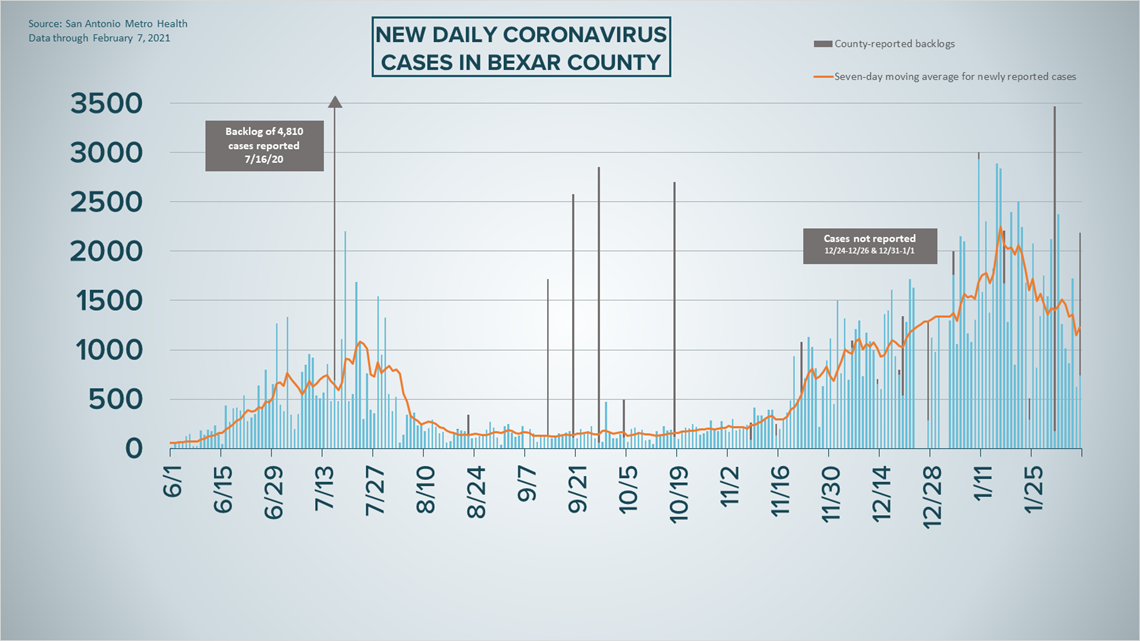
The county's positive trend of decreasing coronavirus hospitalizations continued on Sunday, with 944 patients receiving treatment for their symptoms. That's 25 fewer overall patients compared to Saturday.
Of those 944 patients, 200 are on ventilators and 354 are in intensive care.

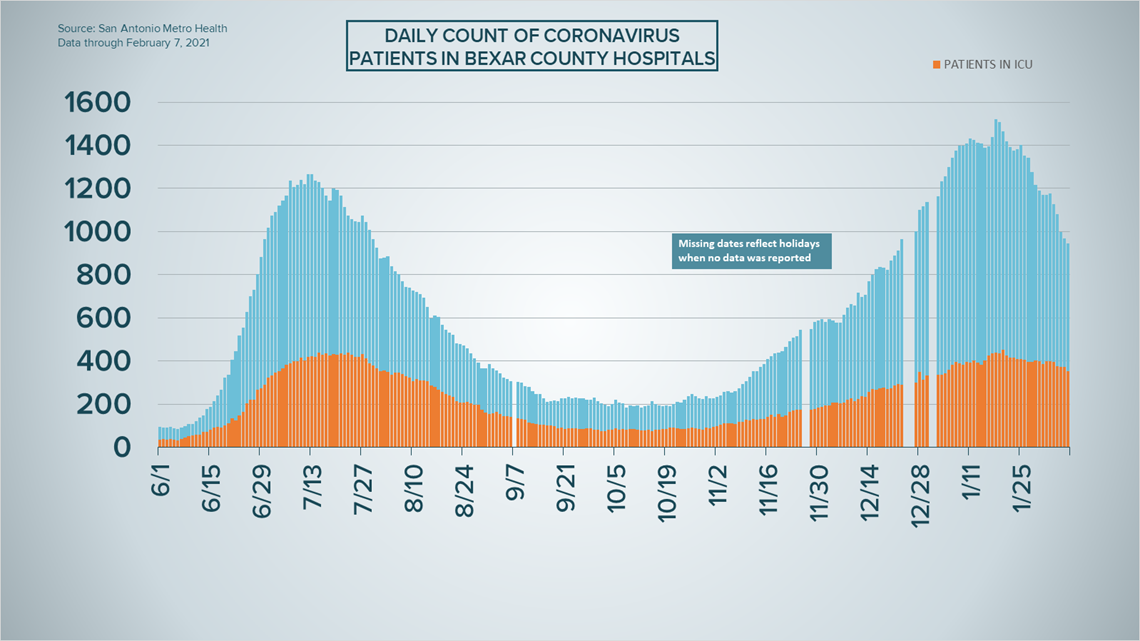
Coronavirus in Texas
The total number of novel coronavirus cases in the state since the pandemic began grew by 6,959 on Sunday, according to the Texas Department of State Health Services. That total includes 5,278 new confirmed cases, 1,499 new probable cases, and a backlog of 182. More details can be found on this page.
Sunday's figures bring the total number of Texans diagnosed with COVID-19 to more than 2.483 million.

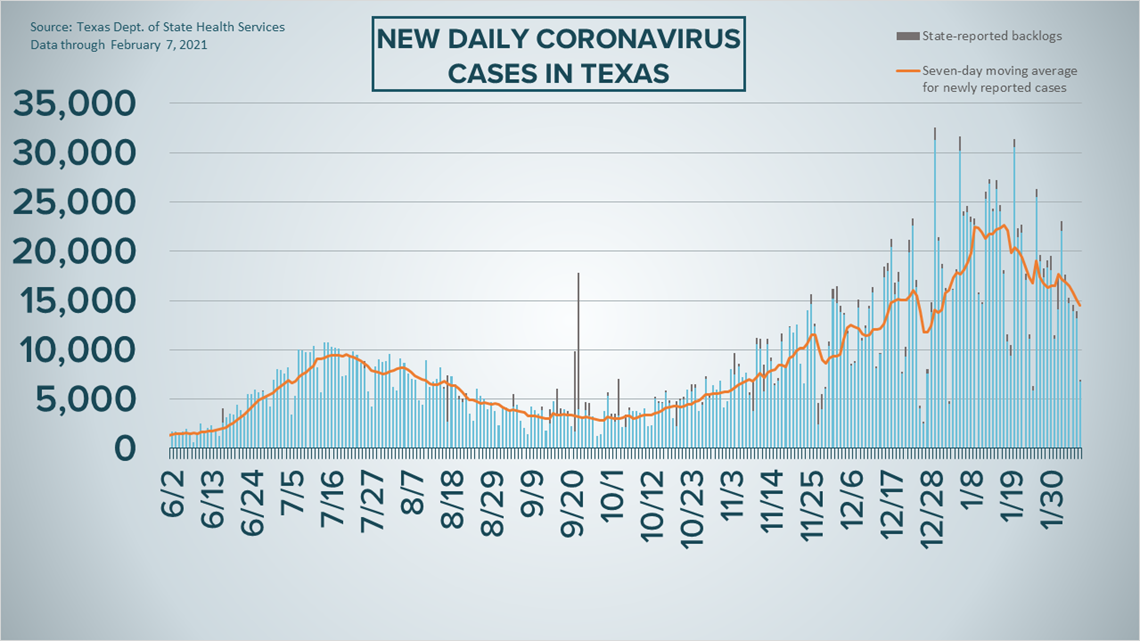
Meanwhile, state health authorities reported another 167 deaths from coronavirus complications in Texas. In all, 38,643 Texans have died from COVID-19.
The number of COVID-19 patients receiving treatment for their symptoms throughout Texas decreased for the 12th consecutive day on Sunday, to 9,652. Sunday marks the second straight day of at least 300 fewer hospitalizations compared to the day prior, and 9,652 is the lowest that the overall COVID-19 hospitalizations figure has been for the Lone Star State since Dec. 17.
The state estimates that about 2.091 million Texans have recovered, while 336,361 Texans remain ill with COVID-19.
The latest update from the Texas Education Agency showed that there have been at least 162,723 cumulative cases among staff and students on Texas public school campuses through January 31. That number comprises 104,365 positive student cases and 58,358 staff cases. More information can be found here.

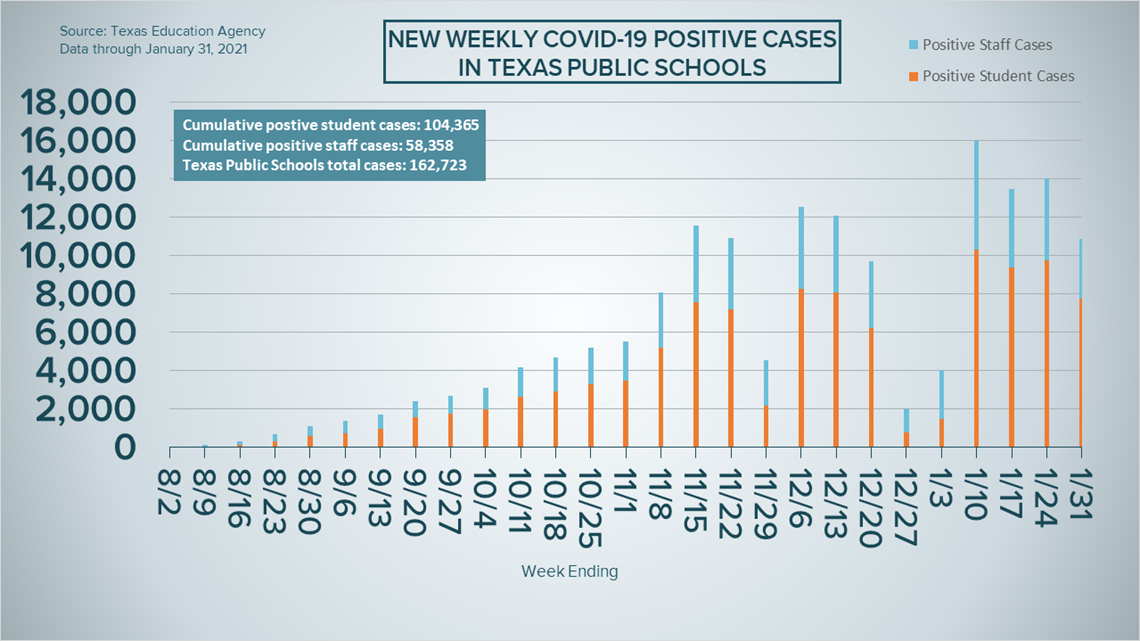
The TEA releases new data on school cases on Fridays.
Latest Coronavirus Headlines
- Which COVID-19 tests are required for international travel?
- Texas COVID hospitalizations numbers fall below 10,000 for first time since mid-December
- Super Bowl superspreader? Health experts urge fans to party remotely
- First known US coronavirus-related death happened one year ago
- Pentagon will deploy troops to assist COVID-19 vaccine drive
- ‘Get Vaccinated' decal added to Patriots plane ahead of Super Bowl flight
- In pandemic, more dying people choosing to be cared for at home
- Calls grow for US to rely on rapid tests to fight pandemic
- Texas doctors praise Johnson & Johnson COVID-19 vaccine as 'game changer'
Coronavirus symptoms
The symptoms of coronavirus can be similar to the flu or a bad cold. Symptoms include fever or chills, cough, shortness of breath or difficulty breathing, fatigue, muscle or body aches, headache, new loss of taste or smell sore throat, congestion or runny nose, nausea or vomiting, and diarrhea, according to the Centers for Disease Control.
Most healthy people will have mild symptoms. A study of more than 72,000 patients by the Centers for Disease Control in China showed 80 percent of the cases there were mild.
But infections can cause pneumonia, severe acute respiratory syndrome, kidney failure, and even death, according to the World Health Organization. Older people with underlying health conditions are most at risk.
Experts determined there was consistent evidence these conditions increase a person's risk, regardless of age:
- Chronic kidney disease
- COPD (chronic obstructive pulmonary disease)
- Obesity (BMI of 30 or higher)
- Immunocompromised state (weakened immune system) from solid organ transplant
- Serious heart conditions, such as heart failure, coronary artery disease, or cardiomyopathies
- Sickle cell disease
- Type 2 diabetes
The CDC believes symptoms may appear anywhere from two to 14 days after being exposed.
Human coronaviruses are usually spread...
- Between people who are in close contact with one another (within about 6 feet).
- Through respiratory droplets produced when an infected person coughs, sneezes or talks. These droplets can land in the mouths or noses of people who are nearby or possibly be inhaled into the lungs.
- Some recent studies have suggested that COVID-19 may be spread by people who are not showing symptoms.
Help stop the spread of coronavirus
- Stay home when you are sick.
- Eat and sleep separately from your family members
- Use different utensils and dishes
- Cover your cough or sneeze with your arm, not your hand.
- If you use a tissue, throw it in the trash.
Find a Testing Location
City officials recommend getting a COVID-19 test if you experience fever or chills, cough, shortness of breath or difficulty breathing, fatigue, muscle or body aches, headache, new loss of taste or smell, sore throat, congestion or runny nose, nausea or vomiting, or diarrhea.
San Antonio operates several no-cost testing locations, including two walk-up locations open Monday-Sunday from 10 a.m. until 2 p.m.:
Cuellar Community Center
5626 San Fernando St.
San Antonio, TX 78237
Ramirez Community Center
1011 Gillette Blvd.
San Antonio, TX 78224
Additionally, Freeman Coliseum offers drive-through no-cost testing from Monday through Sunday between 9 a.m. and 4 p.m. An appointment is required and can be made either online or by calling (833) 213-0643.
Here's a Testing Sites Locator to help you find the testing location closest to you in San Antonio.

